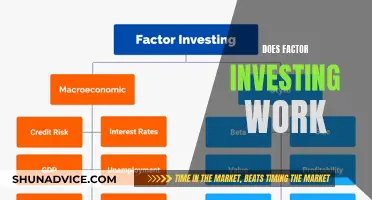
Earnings per share (EPS) is a crucial metric for investors to evaluate a company's profitability and financial health. It measures the company's net income or profits per outstanding share of common stock. A higher EPS indicates greater profitability and value, making the company's stock more attractive to investors. EPS is calculated by dividing the company's net income by the total number of outstanding shares, and it is typically reported quarterly and annually.
When considering an investment project, understanding how a company's EPS might change is essential. An increase in EPS can be achieved through various means, such as increasing sales, improving expense management, share buybacks, or reducing costs. Conversely, EPS can decrease if a company increases its spending on research and development or experiences one-time expenses.
Comparing a company's EPS to its competitors and tracking its EPS growth rate over time can provide valuable insights for investors. Additionally, EPS is used in calculating other financial metrics like the price-to-earnings (P/E) ratio, which is crucial for stock valuation.
In summary, EPS is a fundamental indicator of a company's performance and profitability, and changes in EPS due to investment projects can significantly impact a company's stock price and its attractiveness to investors.
| Characteristics | Values |
|---|---|
| Purpose | To evaluate the profitability of a company and its performance relative to competitors and the market |
| Calculation | Net income (or earnings) divided by the number of common shares outstanding |
| Comparison | Used to compare companies within the same industry |
| Impact on Share Price | A higher EPS indicates a higher stock value compared to competitors |
| Investor Interest | Investors use EPS to assess the potential of a company as an investment |
| Company Reporting | Companies report basic and diluted EPS, and sometimes adjusted EPS |
| Limitations | EPS can be manipulated by share buybacks and doesn't indicate debt level |
What You'll Learn

Basic EPS vs diluted EPS
Earnings per share (EPS) is a key metric used to determine the common shareholder's portion of the company's profit. It is used by investors and analysts to assess company performance, predict future earnings, and estimate the value of the company's shares.
There are two types of EPS: basic EPS and diluted EPS. Basic EPS is calculated by taking into account the company's outstanding equity shares. It is a simple measure of profitability and is useful for companies with a simple capital structure. The formula for basic EPS is:
> Basic EPS = (Net income − Preferred dividend) / Outstanding common shares
Diluted EPS, on the other hand, includes convertible securities such as employee stock options, warrants, and debt in its calculation. It is a more complex and comprehensive measure of profitability, and is useful for companies with complex capital structures. The formula for diluted EPS is:
> Diluted EPS = (Net income + convertible preferred dividend + debt interest) / (All convertible securities + Common shares)
Diluted EPS is considered a stricter approach to understanding a company's financial health. It assumes that all convertible securities will be exercised, and it provides a more accurate picture of a company's financial condition.
A large difference between a company's basic EPS and diluted EPS can indicate the potential for dilution of the company's shares, which is a concern for analysts and investors. Dilution devalues a shareholder's existing equity stake and reduces a firm's earnings per share.
Pelosi's Portfolio: What's She Buying?
You may want to see also

EPS growth
Earnings per share (EPS) is a measure of a company's profitability, calculated by dividing the company's net income by the total number of outstanding shares. EPS is a crucial metric for investors as it indicates how much profit each outstanding share of common stock has earned and is used to estimate a company's corporate value. A higher EPS indicates greater value as investors will pay more for a company's shares if they believe the company has higher profits relative to its share price.
> EPS Growth (%) = (Ending EPS ÷ Beginning EPS) – 1
To interpret this percentage, it must then be multiplied by 100 to convert it from decimal notation.
Analysing EPS growth allows investors to gauge a company's historical profitability and develop an understanding of its near-term trajectory. This can be used to forecast future performance. Comparing the three-year annualised growth rate with the one-year growth rate can show whether a company's EPS growth is speeding up or slowing down.
It is important to note that EPS growth should not be used as a standalone metric when making investment decisions. Instead, it should be analysed in conjunction with other financial metrics.
Infosys: Invest Now or Miss Out?
You may want to see also

Dividend payout ratio
The dividend payout ratio is a financial metric that shows the proportion of earnings a company pays its shareholders in the form of dividends. It is expressed as a percentage of the company's total net income. The dividend payout ratio is calculated using the following formula:
DPR = Total dividends / Net income
The dividend payout ratio is an important metric for investors as it helps them determine which companies align best with their investment goals. A high DPR means the company is reinvesting less money back into its business and paying out more of its earnings in dividends. These types of companies tend to attract income investors who prefer a steady stream of income over potential growth in share price.
On the other hand, a low DPR means the company is reinvesting more money back into expanding its business, which could lead to higher levels of capital gains for investors in the future. These companies tend to attract growth investors who are interested in potential profits from a significant rise in share price.
It is important to note that there is no optimal dividend payout ratio as it depends on various factors such as the industry, nature of the business, maturity, and business plan of the company.
When evaluating a company's dividend payout ratio, investors consider the age and maturity of the company, its financial condition, and the historical payout ratio. A payout ratio above 100% indicates that the company is paying out more in dividends than its earnings can support, which could be unsustainable.
Diversifying Your Retirement: Exploring the Benefits of Multiple Providers
You may want to see also

EPS estimates and surprises
Earnings per share (EPS) is a measure of a company's profitability, indicating how much profit each outstanding share of common stock has earned. It is calculated by dividing the company's net income by the total number of outstanding shares. EPS is an important metric for investors, as it helps them determine a company's financial health and potential for investment.
The Earnings Surprise Prediction (ESP) is a tool used by investors to identify stocks with a high probability of positively surprising in the earnings season. It focuses on companies that have recently experienced positive earnings estimate revisions, as more recent information tends to be more accurate. Combining a positive Earnings ESP with a strong Zacks Rank, a measure of a stock's likely performance, has proven to be effective in predicting positive surprises.
To evaluate the quality of EPS, investors can consider factors such as the company's expense management, margin improvements, and revenue recognition strategies. Comparing EPS across the industry and analysing trends over time can also provide valuable insights. Additionally, examining the cash flow statement and assessing operating cash flow per share relative to EPS can help identify potential red flags or growth opportunities.
Overall, EPS estimates and surprises are crucial factors in investment decisions, as they provide insights into a company's financial health and potential for growth. By analysing these metrics and considering the broader context, investors can make more informed choices and potentially take advantage of market overreactions to earnings surprises.
Retirement Planning: Unlocking the Power of Annuity Investments
You may want to see also

Adjusted EPS
Adjusted earnings per share (EPS) is a profitability measure that indicates how much profit each outstanding share of common stock has earned. It is calculated by taking a company's net income and dividing it by the total number of outstanding shares. The higher a company's EPS, the more profitable it is considered to be, and investors will pay more for a company's shares if they believe the company has higher profits relative to its share price.
A high-quality EPS figure is one that accurately represents what a company earned. This usually involves minimal non-GAAP earnings adjustments and may be influenced by a company's earnings recognition strategy, which can vary by industry. Expense management and increasing margins can also contribute to higher-quality EPS. Conversely, higher expenses, numerous non-GAAP adjustments, and unnecessary changes to shares outstanding can indicate a low-quality EPS report.
Overall, EPS is a crucial metric for evaluating a company's profitability and is widely used to estimate corporate value. It is also a significant component of calculating the price-to-earnings (P/E) ratio, which investors use to assess the value of a stock in terms of how much the market is willing to pay for each dollar of earnings.
Retirement Planning: The Sooner, the Better
You may want to see also
Frequently asked questions
Earnings per share (EPS) is a financial measure that shows a company's net income per outstanding share. It is calculated by dividing a company's net income by the total number of outstanding shares.
A higher EPS indicates greater profitability and value because investors will pay more for a company's shares if they think the company has higher profits relative to its share price.
EPS allows investors to compare different companies, usually within the same industry, on a per-share basis.
A company's share price can be affected by its EPS. When the actual EPS that a company reports is higher than analyst expectations, the share price typically goes up. Conversely, if a company misses its EPS projection, its share price typically falls.







